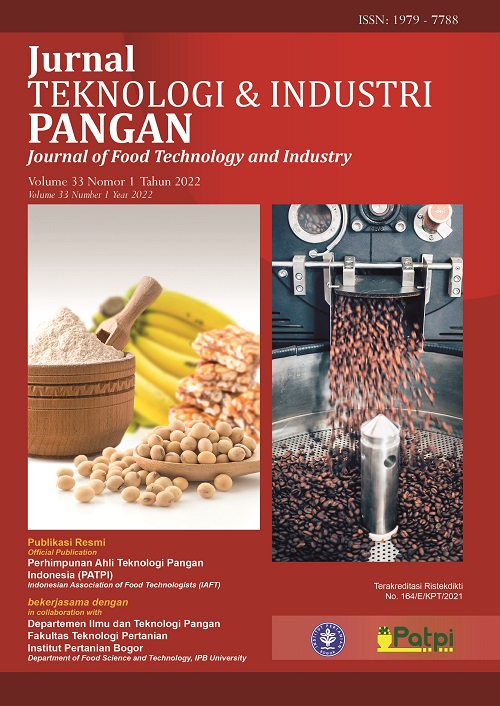Differentiation of beef, buffalo, pork, and wild boar meats using colorimetric and digital image analysis coupled with multivariate data analysis
Abstract
Beef price is relatively expensive, which makes this commodity vulnerable to be counterfeited. The development of rapid, cheap and robust analytical methods for meats authentication has therefore become increasingly important. In this study, colorimetric and digital image analysis methods were used to characterize and classify four types of meat (beef, buffalo, pork, wild boar) and two muscle types from each sample (Semitendinosus and Vastus lateralis). Multivariate data analysis (PCA and OPLS-DA) was used to observe classification pattern among species using different color parameters data obtained from meat chromameter and digital image measurement. The results showed that PCA and OPLS-DA successfully classified meat from different species and different muscle type based on color, both in chromameter and in image analysis. It was shown that pork had the highest lightness level, and was the most different among the four types of meat tested. Beef was predominated by yellowish color, while buffalo meat had the highest reddish color level. Semitendinosus and Vastus lateralis muscles had different color intensity where Vastus lateralis exhibited darker color intensity. This study showed that meat color analysis using chromameter and imaging techniques can be used as cheap and quick tools to discriminate meats form different species and different muscles type.
References
Argañosa FC, Sanchez PC, Ibarra PI, Gerpacio AL, Castilio L, Argañosa VG. 1973. Evaluation of carabeef as a potential substitute for beef. Philippine J Nutr 26: 128-143.
Bateson P, Bradshaw EL. 1997. Physiological effects of hunting red deer (Cervus elaphus). Proc R Soc B Biol Sci 264: 1707-1714. https:// doi.org/10.1098/rspb.1997.0237
De Smet S, Vossen E. 2016. Meat: The balance between nutrition and health. A review. Meat Sci 120: 145-156. https://doi.org/10.1016/j.meat sci.2016.04.008
El Sheikha AF, Mokhtar NFK, Amie C, Lamasudin DU, Isa NM, Mustafa S. 2017. Authentication technologies using DNA-based approaches for meats and halal meats determination. Food Biotechnol 31: 281-315. https://doi.org/10.1080/ 08905436.2017.1369886
Eriksson L, Johansson E, Kettenah-Wold N, Trygg J, Wikström C, Wold S. 2013. Multi- and Megavariate Data Analysis. Umetrics Academy Publisher.
Feiner G. 2006. Meat Products Handbook: Practical Science and Technology. Camridge: Woodhead publishing Ltd.
Girolami A, Napolitano F, Faraone D, Braghieri A. 2013. Measurement of meat color using a computer vision system. Meat Sci 93: 111-118. https://doi.org/10.1016/j.meatsci.2012.08.010
Haralick RM, Shanmugam K, Dinstein I. 1973. Textural Features for Image Classification. SEG Tech Progr Expand Abstr SMC-3: 610-621. https://doi.org/10.1109/TSMC.1973.4309314
Hunt MC, Hedrick HB. 1977. Profile of fiber types and related properties of five bovine muscles. J. Food Sci 42: 513-517. https://doi.org/10.1111/j. 1365-2621.19 77.tb01535.x
Kasprzyk A, Stasiak A, Babicz M. 2010. Meat quality and ultrastructure of muscle tissue from fatte-ners of Wild Boar, Pulawska and its crossbreed Pulawska × (Hamshire × Wild Boar). Arch Anim Breed 53: 184-193. https://doi.org/10.5194/aab-53-184-20100.
King DA, Shackelford SD, Wheeler TL. 2011. Relative contributions of animal and muscle effects to variation in beef lean color stability. J. Anim Sci 89: 1434-1451. https://doi.org/10.252 7/jas.2010-3595
Ledward DA, Johnston DE, Knight MK. 1992. The Chemistry of Muscle-Based Foods. 128–139. The Royal Society of Chemistry, Thomas Graham House, Science Park, Cambridge, U.K.
Müller E, Rutten M, Moser G, Reiner G, Barten-schlager H, Geldermann H. 2002. Fibre struc-ture and metabolites in M. longissimus dorsi of Wild Boar, Pietrain and Meishan pigs as well as their crossbred generations. J Anim
Breed Genet 119: 125-137. https://doi.org/10.1046/j. 1439-0388.2002.00328.x
Newcom DW, Stalder KJ, Baas TJ, Goodwin RN, Parrish FC, Wiegand BR. 2004. Breed diffe-rences and genetic
parameters of myoglobin concentration in porcine longissimus muscle. J Anim Sci 82: 2264-2268. https://doi.org/10.2 527/2004.8282264x
Page JK, Wulf DM, Schwotzer TR. 2001. A survey of beef muscle color and pH. J Anim Sci 79: 678-687. https://doi.org/10.2527/2001.793678x
Park B, Lu R. 2015. Hyperspectral imaging techno-logy in food and agriculture. In: Park B, Lu R, editor. 1-390. Hyperspectral Imaging Technolo-gy in Food and Agriculture. 1st Ed Springer-Verlag New York.
Price JF, Schwiegert BS. 1987. The Science of Meat and Meat Products. 3rd ed. Food and Nutrition Press, Westport, CT.
Ropodi AI, Pavlidis DE, Mohareb F, Panagou EZ, Nychas GJE. 2015. Multispectral image ana-lysis approach to detect adulteration of beef and pork in raw meats. Food Res Int 67: 12-18. https://doi.org/10.1016/j.foodres.2014.10.032
Sales J, Kotrba R. 2013. Meat from wild boar (Sus scrofa L.): A review. Meat Sci 94: 187-201. https://doi.org/10.1016/j.meatsci.2013.01.012
Seideman SC, Cross HR, Smith GC, Durland PR. 1984. Factors Associated with fresh meat color: a Review. J Food Qual 6: 211-237. https:// doi.org/10.1111/j.1745-4557.1984.tb00826.x
Sinanoglou VJ, Cavouras D, Xenogiannopoulos D, Proestos C, Zoumpoulakis P. 2018. Quality assessment of pork and Turkey hams using FT-IR spectroscopy, colorimetric, and image ana-lysis. Foods 7: 152. https://doi.org/10.3390/ foods7090152
Wang F, Holman BWB, Zhang Y, Luo X, Mao Y, Hopkins DL. 2020. Investigation of colour requirements of frozen beef rolls by Chinese consumers for hot pot. Meat Sci 162: 108038. https://doi.org/10.1016/j.meatsci.2019.108038
Wibowo A, Panpipat W, Kim SR, Chaijan M. 2019. Characteristics of Thai native beef slaughtered by traditional Halal method. Walailak J Sci Technol 16: 443-453. https://doi.org/10.48048/ wjst.2019.4689
Worley B, Powers R. 2016. PCA as a Practical indicator of OPLS-DA model reliability. Curr. Metabolomics 4: 97-103. https://doi.org/10.217 4/2213235X04666160613122429
Zheng C, Sun D. 2006. Recent applications of image texture for evaluation of food qualities-a review. Trends Food Sci Technol 17: 113-128. https:// doi.org/10.1016/j.tifs.2005.11.006

